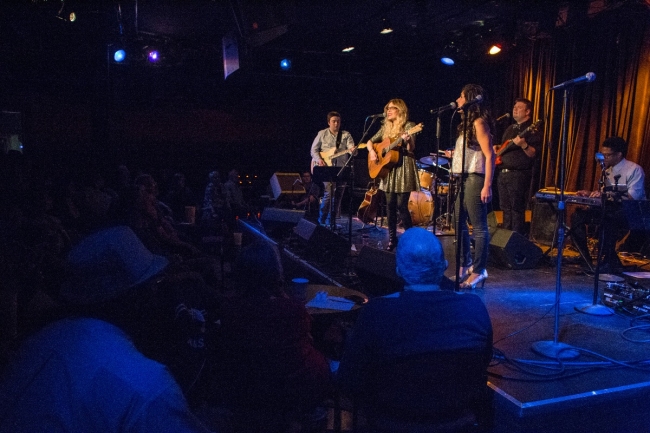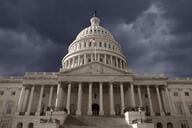You have /5 articles left.
Sign up for a free account or log in.

A local band performs at the Ark, a concert venue in downtown Ann Arbor, Mich.
Getty Images
The local economies of college towns were hit especially hard during the COVID-19 pandemic, as students fled, employees stayed home and families, alumni and prospective students stopped visiting.
For many downtowns that depend largely on a university population to thrive, things are looking much brighter this year. On Tuesday afternoon, Cornell University organized a virtual forum of college and community experts to discuss their struggles and successes in reviving local economies post-pandemic.
For Gary Stewart, associate vice president for community relations at Cornell, the key to survival for both college and community was to work together, no matter how bleak the circumstances.
“Town-gown relations are an inexact science,” Stewart said in a statement to Inside Higher Ed, but the fact that so many college towns are bouncing back illustrates the “unprecedented spirit of town-gown collaboration during a national crisis. Thanks to a rigorous science-based approach and our community collaborations, we were able to provide students with a meaningful, in-person experience starting from the fall 2020 semester.”
In State College, home to Pennsylvania State University (student population: 89,000), purchases made in town by employees with university-issued credit cards fell 60 percent for fiscal year 2019–20. Additionally, university purchase orders fell 27 percent for fiscal year 2020–21. State College also lost over $6.2 million in revenue during the pandemic, according to information Penn State shared during the panel.
Greg Scott, president and CEO of the Chamber of Business & Industry of Centre County, said college-related tourism is central to the county's economy.
“A lot of our economy is driven through tourism—the hospitality areas, retail, associated with not only the students that are here, but those coming to visit on a regular basis,” Scott said. “So as expected, our economy took a big hit during the pandemic as the university shut down, like most everybody across the country.”
Lee Ann Jeffries, executive director at Downtown State College Improvement District, said that there aren’t many other tourist destinations in central Pennsylvania; the next nearest city to State College is about 150 miles away.
“Just to give you an idea of how our downtown was affected by the pandemic in 2020 and 2021 combined, we lost 17 businesses due to pandemic-related issues,” Jeffries said. But now that students are back and everything is reopened, “we were fortunate to gain 16 new businesses—despite the odds—that opened in 2021.” The new establishments include restaurants, bars and markets.
Ann Arbor, Mich., has a population of about 123,000, almost half of which is connected to the University of Michigan, home to about 51,000 students, said Michael Rein, the university’s community relations director. But because only about 12 percent of students live in campus housing, the vast majority live—and eat and shop—in the city of Ann Arbor. That makes it critical that the university maintain a strong relationship with city leadership, Rein said.
During the worst of the pandemic, the city’s hotel occupancy rate dropped to 20 percent—from an average of 60 percent—and Ann Arbor lost half its hospitality workforce, said Chad Wiebesick, vice president of marketing and communications at Destination Ann Arbor. Now the city’s hotel occupancy rate has climbed back to between 40 and 50 percent, which is a sign that things are returning to normal, Wiebesick said.
The loss of college athletics during the pandemic also deeply impacted D-1 college town revenues. John Tayer, president and CEO of the Boulder Chamber, said the University of Colorado Boulder regularly generates about $5 million per home football game.
Tom Fountaine, State College borough manager, said during one Penn State football weekend in April 2019, State College generated $75,000 in parking revenue from three garages alone. On that same weekend a year later, the total was $9.40.
“I think it gives you some idea of the really significant impact of what the college town experienced through that time,” Fountaine said.
Wiebesick said Ann Arbor is on the road to recovery because of the return of college-related activities, including conferences, campus visits and athletic events. He said local businesses really benefited from the fact that the University of Michigan hosted eight home football games this school year.
“A home football game has a $10 million economic impact to the local economy,” Wiebesick said.
In Boulder (student population: 35,000), the pandemic drove up housing prices, which made it difficult for students and university employees to actually live in the city and interact with local businesses, said Lori Call, assistant vice chancellor for local government and community relations at CU Boulder. According to the National Association of Realtors’ quarterly report, the Boulder metropolitan area was ranked seventh as the most expensive metro area in the nation in 2020. Tayer said housing prices are “through the roof,” with a median of $1.4 million. The average rental price is $2,263 for an 825-square-foot apartment.
“That’s not affordable for an average student or faculty,” Tayer said. “So the consequence of that is we have a great deal of commuters coming into our town, and a challenge with workforce attraction, because to the extent that it’s difficult to recruit folks who can’t buy a house or rent at a reasonable rate—or are just disturbed by large commute patterns—those are things that we recognize as a challenge for the business community, but also for the university.”
The loss of in-person learning at Cornell (student population: 25,000) dramatically impacted the economy in Ithaca, N.Y., said Peggy Coleman, vice president of tourism and community relations at Tompkins Chamber. Visitor spending decreased by 46 percent, reducing visitor-supported tax revenue by 32 percent, and air travel fell by 70 percent, she said.
But one saving grace for Ithaca was the waterfalls and gorges surrounding the university, which Coleman said played a key role in the revival of tourism.
“People were leaving dense cities, especially in the New York City and Philadelphia area, and they could drive to us,” Coleman said. “And really they were craving those wide-open spaces and the calming impacts of our destination as well as the community culture.”
Ithaca also will owe its economic recovery in part to the construction of a new conference center downtown, which includes 15,000 square feet of bookable function space and 350 parking spaces, Coleman said. That will allow Cornell to host more academic and professional conferences, bringing more revenue back to the area.
“We really need to come up with creative ways to get people back into the offices or repurpose those offices in our downtown to sustain our businesses and our restaurants,” Coleman said.




